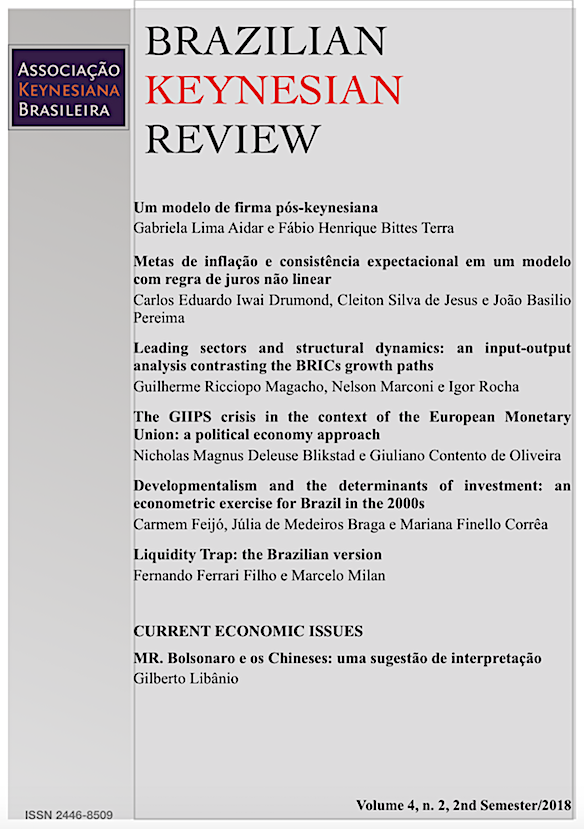Metas de inflação e consistência expectacional em um modelo com regra de juros não linear
Resumo
O principal objetivo deste artigo é construir um modelo macroeconômico de inspiração pós-keynesiana que leve em conta uma não-linearidade na regra de juros. Assume-se que a autoridade monetária considera, na determinação da taxa de juros, a interação entre a taxa de inflação e o nível de utilização da capacidade instalada, de modo que a sensibilidade da regra de juros ao hiato da inflação com relação à uma meta varia de acordo com o ciclo econômico. O arcabouço de política macroeconômica proposto no trabalho permite que a autoridade monetária possa dar peso tanto à inflação quanto ao produto sem perder de vista o papel de ancora expectacional da meta de inflação.
Downloads
Referências
Ball, L., & Sheridan, N. (2003). Does Inflation Targeting Matter? (NBER Working Papers No. 9577). Cambridge, MA. https://doi.org/10.3386/w9577
Blinder, A. S. (1997). Distinguished Lecture on Economics in Government: What Central Bankers Could Learn from Academics—and Vice Versa. Journal of Economic Perspectives, 11(2), 3–19. https://doi.org/10.1257/jep.11.2.3
Carvalho, F. J. C. de. (2015). Liquidity Preference and Monetary Economies. London: Routledge. https://doi.org/10.4324/9781315734385
Clarida, R., Galí, J., & Gertler, M. (1999). The Science of Monetary Policy: A New Keynesian Perspective. Journal of Economic Literature, 37(4), 1661–1707. https://doi.org/10.1257/jel.37.4.1661
Cukierman, A., & Muscatelli, A. (2008). Nonlinear Taylor Rules and Asymmetric Preferences in Central Banking: Evidence from the United Kingdom and the United States. The B.E. Journal of Macroeconomics, 8(1), 2008. https://doi.org/10.2202/1935-1690.1488
Dolado, J. J., María-Dolores, R., & Naveira, M. (2005). Are monetary-policy reaction functions asymmetric?: The role of nonlinearity in the Phillips curve. European Economic Review, 49(2), 485–503. https://doi.org/10.1016/S0014-2921(03)00032-1
Drumond, C. E., & De Jesus, C. S. (2016). Monetary and fiscal policy interactions in a post Keynesian open-economy model. Journal of Post Keynesian Economics, 39(2), 172–186. https://doi.org/10.1080/01603477.2016.1147332
Drumond, C. E., & Porcile, G. (2012). Inflation targeting in a developing economy: policy rules, growth, and stability. Journal of Post Keynesian Economics, 35(1), 137–162. https://doi.org/10.2753/pke0160-3477350108
Gonçalves, C. E. S., & Salles, J. M. (2008). Inflation targeting in emerging economies: What do the data say? Journal of Development Economics, 85(1–2), 312–318. https://doi.org/10.1016/j.jdeveco.2006.07.002
Hein, E., Lavoie, M., & van Treeck, T. (2011). Some instability puzzles in Kaleckian models of growth and distribution: a critical survey. Cambridge Journal of Economics, 35(3), 587–612. https://doi.org/10.1093/cje/beq026
Jesus, C. S., & Correia, F. M. (2016). Active fiscal policy and macroeconomic stability. Journal of Economic Studies, 43(5), 749–762. https://doi.org/10.1108/JES-03-2015-0052
Lima, G. T., & Setterfield, M. (2008). Inflation targeting and macroeconomic stability in a Post Keynesian economy. Journal of Post Keynesian Economics, 30(3), 435–461. https://doi.org/10.2753/PKE0160-3477300307
Martin, C., & Milas, C. (2004). Modelling monetary policy: Inflation targeting in practice. Economica, 71(282), 209–221. https://doi.org/10.1111/j.0013-0427.2004.00366.x
Mendonça, H. F., & de Guimarães e Souza, G. J. (2012). Is inflation targeting a good remedy to control inflation? Journal of Development Economics, 98(2), 178–191. https://doi.org/10.1016/j.jdeveco.2011.06.011
Montes, G. C. (2009). Reputation, credibility and monetary policy effectiveness. Estudos Econômicos (São Paulo), 39(3), 673–698. https://doi.org/10.1590/S0101-41612009000300009
Porcile, G., de Souza, A. G., & Viana, R. (2011). External debt sustainability and policy rules in a small globalized economy. Structural Change and Economic Dynamics, 22(3), 269–276. https://doi.org/10.1016/j.strueco.2011.06.002
Rochon, L.-P., & Setterfield, M. (2007). Interest rates, income distribution, and monetary policy dominance: Post Keynesians and the “fair rate” of interest. Journal of Post Keynesian Economics, 30(1), 13–42. https://doi.org/10.2753/pke0160-3477300101
Rowthorn, R. (1977). Conflict, inflation and money. Cambridge Journal of Economics, 1(3), 215–239. https://doi.org/10.1093/oxfordjournals.cje.a035360
Santos, A. L. M. (2011). Inflation targeting in a Post Keynesian economy. Journal of Post Keynesian Economics, 34(2), 295–318. https://doi.org/10.2753/PKE0160-3477340206
Schmidt-hebbel, K., & Carrasco, M. (2016). The Past and Future of Inflation Targeting. In C. Ghate & K. Kletzer (Eds.), Manuscript (pp. 583–622). New Delhi: Springer.
Setterfield, M. (2006). Is inflation targeting compatible with Post Keynesian economics? Journal of Post Keynesian Economics, 28(4), 653–671. https://doi.org/10.2753/pke0160-3477280407
Setterfield, M. (2007). The rise, decline and rise of incomes policies in the US during the post-war era: an institutional-analytical explanation of inflation and the functional distribution of income. Journal of Institutional Economics, 3(2), 127–146. https://doi.org/10.1017/S1744137407000665
Setterfield, M. (2009). Fiscal and monetary policy interactions: lessons for revising the EU Stability and Growth Pact. Journal of Post Keynesian Economics, 31(4), 623–643. https://doi.org/10.2753/pke0160-3477310406
Setterfield, M. (2017). Long-run variation in capacity utilization in the presence of a fixed normal rate, (New School for Social Research Working Papers No. 1704). https://doi.org/10.2139/ssrn.2929112
Surico, P. (2007). The Fed’s monetary policy rule and U.S. inflation: The case of asymmetric preferences. Journal of Economic Dynamics and Control, 31(1), 305–324. https://doi.org/10.1016/j.jedc.2005.11.001
Tobin, J. (1985). Theoretical Issues in Macroeconomics. In G. Feiwel (Ed.), Issues in Contemporary Macroeconomics and Distribution (pp. 103–133). London: Palgrave Macmillan UK. https://doi.org/10.1007/978-1-349-06879-1_2
Tobin, J., & Buiter, W. (1976). Long-run effects of fiscal and monetary policy on aggregate demand. In J. Stein (Ed.), Monetarism (pp. 273–336). Amsterdam: North Holland.
Turnovsky, S. (1995). Methods of Macroeconomic Dynamics. Cambridge, MA: MIT Press.
Wray, L. (1998) Understanding Modern Money. Cheltenham: Edward Elgar.
Wray, L. R. (2014). From the State Theory of Money to Modern Money Theory: An Alternative to Economic Orthodoxy (Levy Economics Institute of Bard College Working Paper No. 792). https://doi.org/10.2139/ssrn.2407711
Copyright (c) 2019 Carlos Eduardo Iwai Drumond, Cleiton Silva de Jesus, João Basilio Pereima

This work is licensed under a Creative Commons Attribution 4.0 International License.
- Autores mantém os direitos autorais e concedem à revista o direito de primeira publicação, com o trabalho simultaneamente licenciado sob a Licença Creative Commons Attribution que permite o compartilhamento do trabalho com reconhecimento da autoria e publicação inicial nesta revista.
- Autores têm autorização para assumir contratos adicionais separadamente, para distribuição não-exclusiva da versão do trabalho publicada nesta revista (ex.: publicar em repositório institucional ou como capítulo de livro), com reconhecimento de autoria e publicação inicial nesta revista.
- Autores têm permissão e são estimulados a publicar e distribuir seu trabalho online (ex.: em repositórios institucionais ou na sua página pessoal) a qualquer ponto antes ou durante o processo editorial, já que isso pode gerar alterações produtivas, bem como aumentar o impacto e a citação do trabalho publicado (Veja O Efeito do Acesso Livre).


